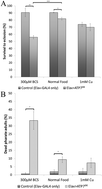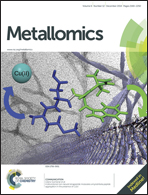Copper overload and deficiency both adversely affect the central nervous system of Drosophila†
Abstract
The human copper homeostasis disorders Menkes and Wilson disease both have severe neurological symptoms. Menkes is a copper deficiency disorder whereas Wilson disease patients suffer from copper toxicity, indicating that tight control of neuronal copper levels is essential for proper nervous system development and function. Here we examine the consequences of neuronal copper deficiency and excess in the Drosophila melanogaster nervous system, using targeted manipulation of the copper uptake genes Ctr1A and Ctr1B and efflux gene ATP7 in combination with altered dietary copper levels. We find that pan-neuronal over expression of Ctr1B and ATP7 both result in a reduction in viability. The effects of Ctr1B over expression are exacerbated by dietary copper supplementation and rescued by copper limitation indicating a copper toxicity phenotype. Dietary manipulation has the opposite effect on ATP7 over expression, indicating that this causes neuronal copper deficiency due to excessive copper efflux. Copper deficiency also causes a highly penetrant developmental defect in surviving adult flies which can be replicated by both copper excess and copper deficiency targeted specifically to a small subset of neuropeptidergic cells. We conclude that both copper overload and excess have detrimental effects on Drosophila neuronal function, reducing overall fly viability as well as impacting on a specific neuropeptide pathway.


 Please wait while we load your content...
Please wait while we load your content...